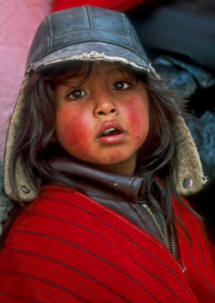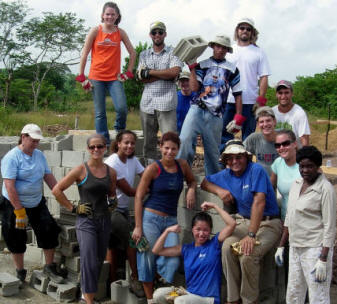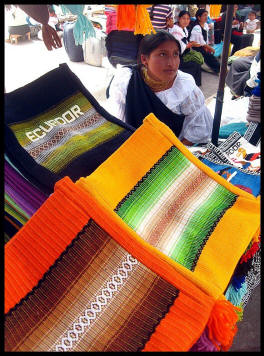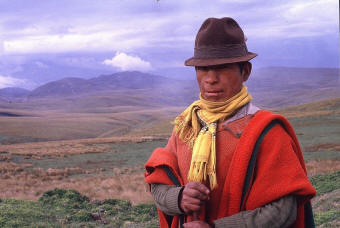Trip Details
This page is a collection of the planning & preparatory information that was disseminated before the short-term mission trip to Ecuador occurred. For pictures and reports of the actual trip experience, please visit the Trip Highlights page. You can also review the What To Bring page, or read What To Expect which applies generally to all Columbus Global Village team mission trips.
Habitat for Humanity—Ecuador has prepared a very informative Team Member's Manual. Although 21 pages may seem like a lot, it has many pictures so it's really a pretty quick read. Please grab a copy of it in plenty of time so you can absorb the information before you leave. We have found our past trips to be much more fun and rewarding with a good understanding of the kind of information in this manual. Enjoy!

Copyright mailto:info@proframe.orgHenk Meijer
mailto:info@proframe.org(Proframe Photography)
Destination: Guayaquil
Guayaquil the largest city in Ecuador, is a seaport that handles over half of the country's imports and exports. Home to over 3 million people, it is a dynamic and growing area that is in transition as it tries to position itself as a tourist destination. Here are several links to pages where you can learn more about the area:
- http://www.inguayaquil.com/cityoverview.htmlCity overview at inguayaquil.com
- Guayaquil photos at Ecuador365.com
- Populists' view at wikitravel.org
- http://www.ahorre.com/ecuador/guayaquil_travel.htmList of things to see in Guayaquil at ahorre.com
All team members are asked to meet on Saturday, June 14 between ??:00 a.m. and ??:00 p.m. local time at the airport in ?? (airport code ??). The HfH staff coordinator will meet us at the airport. We ask team members to wear the Global Village t-shirt they will receive from HFHI to ease finding each other.
Usually our first stop would be to a bank or foreign exchange house at or near the airport to obtain some local currency. However, since Ecuador officially uses US Dollars we will happily skip this bit of complexity.
Guayaquil is located in the coastal zone where we can expect sub-tropical, dry season conditions. We do not expect much rain and the temperatures will be relatively modest for an equatorial destination, ranging from the mid-60s overnight to the high-80s during the day (19 to 31 degrees Celsius).
This map Expedia map shows Guayaquil, and you can zoom out for additional perspective.

Photo by Susi Havens-Bezaire
Construction of Habitat houses in Ecuador
We will fill in additional details of the construction process as they become available.
Habitat for Humanity houses in Ecuador are typically in the 500 square foot range (about 45 square meters) depending on family size and needs, and include 2 or 3 bedrooms, a living-dining room, a kitchen and a bathroom. Houses are built of a concrete and blocks with steel-reinforcement, cement floors and strong roofs to withstand seismic activity. The average cost of the houses is $9,480 (US Dollars). The families' monthly mortgage payments are typically about $90 (US Dollars).
A primary goal is to work side-by-side with partner families and other local volunteers. Please be aware, however, that most people have to work at their jobs every day, and some might live quite a distance from the site. Although they generally can not be with us all the time, we hope that they will be able to join us when they can. This is why we always ask that the schedule includes working on Saturdays.
Please review our What To Expect page for a more complete picture of the entire experience.
Affiliate Development
In addition to construction work, we have offered our help with advocacy and PR efforts. We hope to learn more specifics soon about the feasibility, but initial thoughts include meeting community leaders and helping to recruit local donors, families & volunteers. This will primarily be a Sunday and/or evening activity, although we will welcome the chance to "be seen" and interact to people even as we walk or ride to/from the site each day.
The affiliate has been told that we may be able to garner some extra resources through our fundraising efforts. They noted the need for tools, and would be most appreciative if we can help them out in this manner. We will wait and purchase exactly what may be needed locally rather than try to carry tools or supplies from home.
Climate & Weather
Based on this summary from WordTravels.com, Ecuador enjoys "summer" year round:
The varied geography of Ecuador means the country is divided into several micro-climatic zones. The weather on the coast is constantly hot accompanied by high humidity during the rainy season between December and May. The mountainous area is cooler, depending on the altitude. The Amazon region is tropically hot and humid. The offshore Galápagos Islands have a dry climate with a constant annual temperature of around 77°F (25°C).
Here are the current conditions near Tosagua or you can look at a summary of the conditions last June in the area.

Photo courtesy of Daniel Yoffe
Accommodations
We will probably be staying in a church, retreat center or small hotel that provides clean, simple, safe, inexpensive housing. We hope to be located within easy walking distance of both the construction site and some shops where we can obtain convenience items.
Typically each room accommodates two people and has a private bathroom, though it is possible that we will have dormitory style accommodations. We don't expect air conditioning, which is actually quite a benefit as we acclimate to working in the heat. You'll be amazed at how "cool" a 73 degree morning can feels when you work the rest of the day in the hot sun!
To help safeguard our passports and valuables, we will bring a hard-sided suitcase with a bicycle cable and padlock so we can secure them in our room or the office.
Our meals will be from a variety of sources, all prepared with clean water and under sanitary conditions appropriate for our "gringo" stomachs. Typically breakfast and dinner are provided at the lodging facility. We hope that lunch will be eaten on the work site together with any family members, staff, and other volunteers present at the time. Dinner will likely be either at the lodging facility, or else we will go to one or two local restaurants. Although we always make "advance reservations", don't get your hopes up for anything but the simplest of fare!
If you haven't already done so, please review our What To Expect page for a more complete picture of the entire experience.

Photo courtesy of Patrick Lepetit
R&R
Balancing our building and advocacy work will be some R&R time to further explore the culture.
- Sundays will be a time to experience local church service and spend an afternoon getting to know the area markets, museums, etc. Hopefully some homebuyer families and/or other volunteers will be along so we can get to know more about them, their jobs, etc.
- We hope to learn a bit about local music, dance, crafts and customs in the evenings. A perennial favorite that we hope can be arranged is a cooking "class" to learn about Ecuadorian food preparation -- and maybe even a reciprocal where we provide them with a taste of our own specialties!
- We will attempt to arrange a simple sporting event like soccer with the families, staff and local volunteers as another way to help everyone get to know and feel comfortable with each other.
- After the conclusion of our work, we will take a day and a half to explore Cuenca, the 3rd largest city in Ecuador and a UNESCO World Cultural Heritage site. Read http://www.exploringecuador.com/en_ar_cuenca_ecuador.htma bit about this highlands city and the nearby El Cajas National Park, learn all that we can see and do in Cuenca, and see a bit about http://www.casa-ordonez.com/the little B&B where we will stay, and you'll probably agree that we'll likely run ourselves ragged for our R&R!
- Optionally, Dave & Susi invite you to join them on an extended tour of the Galápagos Islands after the conclusion of our regular mission trip.
Pricing Information
The price is $1,650 to $2,025 per person plus round trip airfare. For example, for people from Columbus, we expect flights to cost about $700 to $800 for a grand total of $2,350 to $2,825 each.
Description |
Amount |
Payable To |
| Round trip airfare. Although we will negotiate a package through http://www.twinhorizonstravel.comTwin Horizons Travel, you are free to make your own arrangements. | $700 to $1000 depending on origin | GV Team or travel agent |
| Mission days food, lodging, ground transportation and activities | $610 | HFHI |
| R&R days food, lodging, ground transportation and activities | $390 | HFHI |
| Travel health insurance | $45 | HFHI |
| Donation to Habitat for Humanity International to support the Global Village program | $100 | HFHI |
| Donation to HfH Ecuador for house materials | $350 | HFHI |
| Columbus GV Team administration & First Aid Kits | $41 | HFHI |
| Contingency | $80 | HFHI |
| Special donation for tools and churches | $34 | HFHI |
| Immunizations and malaria tablets | $0 to $275 | Others |
| U.S. Passport (renewal required if expiration is earlier than Feb 1, 2008) | $0 to $100 | Others |
| Ecuadorian departure tax payable at airport | Included in airfare | Others |
Read about Tax Deductions and the Cancellation Policy here.
Health & Safety Information
Fortunately, we are traveling to a relatively safe area. Nonetheless, it is prudent to be aware of some standard precautions that apply to all of our trips. If, after reading the standard precautions, you wish to visit the Centers of Disease Control site, click here to jump to the Ecuador page.

 Who
Who